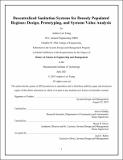Decentralized Sanitation Systems for Densely Populated Regions: Design, Prototyping, and Systems Value Analysis
Author(s)
Tsang, Andrew Lee
DownloadThesis PDF (2.471Mb)
Advisor
Siddiqi, Afreen
Moser, Bryan R.
Terms of use
Metadata
Show full item recordAbstract
Approximately 7.5 billion people live presently on earth, and 2.3 billion lack access to basic sanitation facilities such as toilets or latrines. The International Water Association estimates that 80% of all wastewater gets discharged into waterways. Untreated wastewater affects the community as easily as water flows. Toilets with septic tanks and latrines are the primary repositories for human waste today. However, the essential subsequent task of disposing that fecal sludge or septage is rarely done in a safe manner. A lack of safe, official dumping sites means this sludge and septage is discretely disposed of in water ways, pits, or drains, which affect the local health and aesthetics.
The main question posed in this thesis is “What are cost effective ways to building sanitation infrastructure in developing countries?” This thesis presents a design of a decentralized system conceptualized, prototyped, and analyzed using tools of systems engineering and systems analysis. The development of a lab-scale processor is presented in this thesis. The lab scale system processes 3.5kg of 20% sludge per hour. Using a trade space analysis, the system is compared to other methods of fecal sludge processing; a decentralized method can obtain similar health results for 15-25% of the cost per person served. A systems complexity analysis was done to compare options, and then the economic implementation was analyzed using Monte Carlo simulation. The findings suggest a decentralized model is very cost effective, but not cost effective enough to be a standalone business outside of government purchase.
Date issued
2021-06Department
System Design and Management Program.Publisher
Massachusetts Institute of Technology